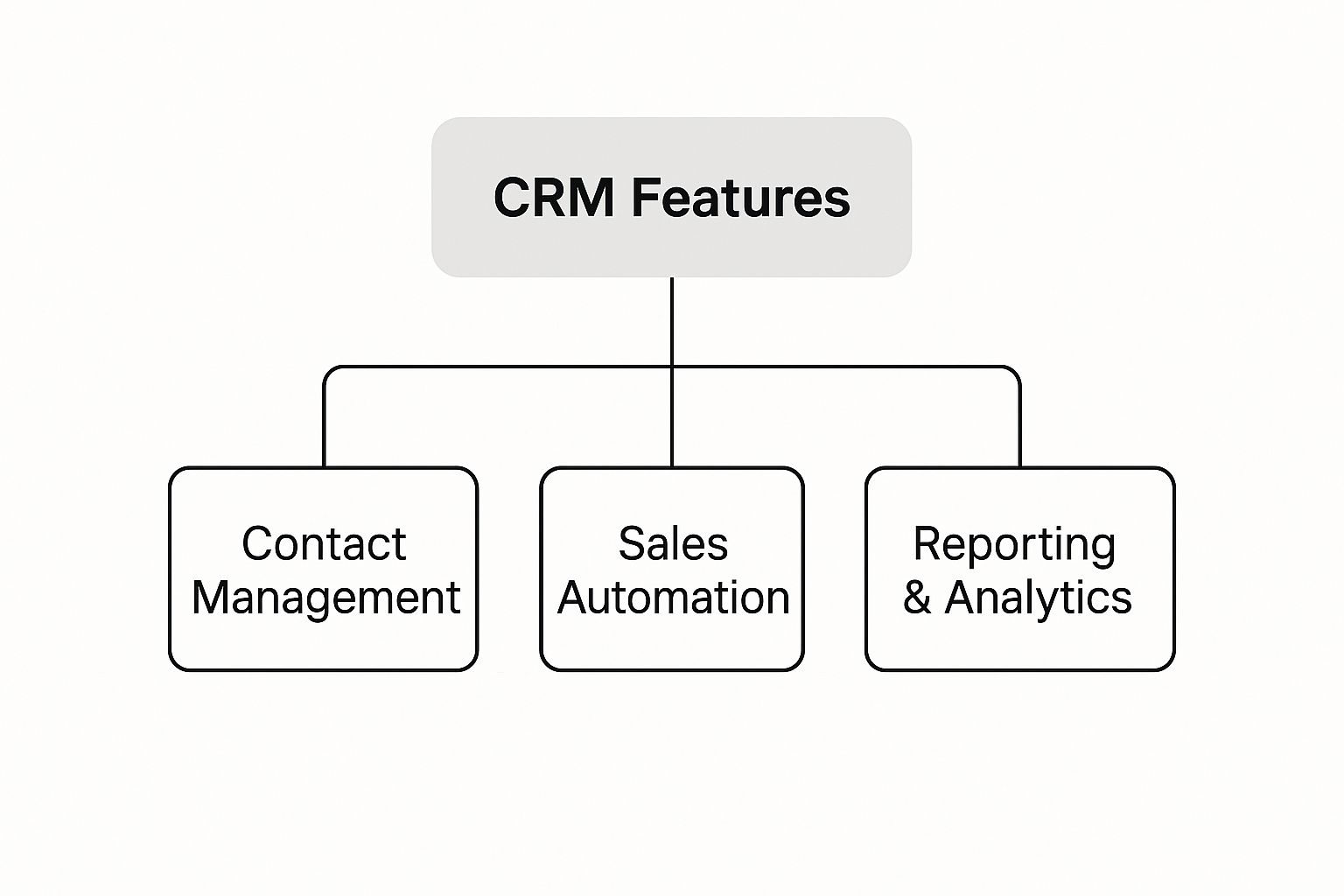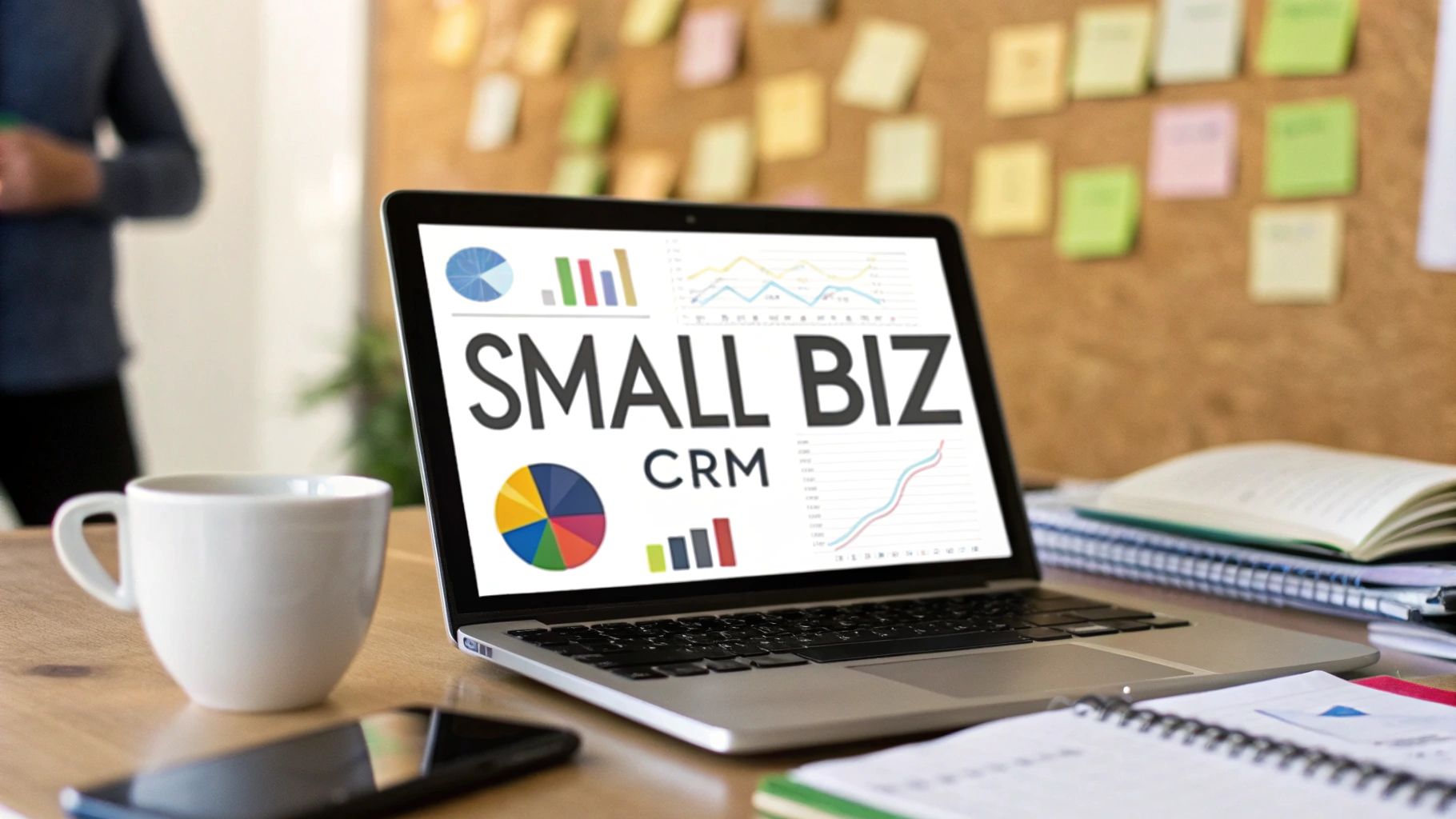A CRM is essentially a central hub for all your customer information, interactions, and sales efforts. It’s the tool that finally lets you ditch the messy spreadsheets and stop letting good opportunities slip away. Instead of chaos, you get a clear, organized system for building relationships and, ultimately, growing your business.
Why Your Small Business Needs a CRM Now
Are you juggling customer notes on sticky pads, in spreadsheets, and buried in your inbox? Do you ever get that sinking feeling that a promising lead went cold simply because a follow-up was missed? These are classic growing pains for small businesses.
Picture a local bakery that's suddenly a hit. In the early days, the owner knew every regular's go-to order. But as the customer base explodes, those little details start to get lost. Orders get mixed up, and that personal touch that built their reputation starts to fade. Sound familiar?
That’s exactly where a CRM for small business comes into play. This isn't some overly complicated piece of corporate software meant for giant companies. It’s a straightforward command centre built for your growth. Think of it as a shared digital memory for your entire team, neatly storing every conversation, email, and deal in one place.
From Chaos to Control
Trying to track every interaction by hand just doesn't work long-term. As your business grows, information gets trapped in different inboxes, notebooks, and random files. This kind of disorganization is a direct path to lost sales and unhappy customers.
A good CRM system puts an end to that by giving you:
- A Single Source of Truth: Anyone on your team can pull up a customer's complete history. This means everyone is on the same page, leading to smoother and more informed conversations.
- Automated Reminders: It’s your safety net. The system will nudge you to follow up with leads, making sure no opportunity falls through the cracks.
- Clear Sales Visibility: You get a bird's-eye view of your entire sales pipeline. You'll know exactly where every potential deal is at, so you can focus your energy where it'll have the biggest impact.
A CRM turns your customer data from a disorganized liability into your most powerful asset for building lasting relationships and generating predictable revenue.
Putting a CRM in place is one of the smartest moves a small business can make. The numbers back it up, too. Recent data shows the average return on investment for a CRM can be as high as $45.72 for every dollar spent. When you’re running a small business, every dollar counts, and that kind of return makes it a no-brainer. You can dive deeper into CRM ROI statistics to see just how powerful it can be.
This guide will give you a clear roadmap to choosing and using a CRM to finally get your customer management under control.
What a CRM Is and How It Actually Works

Let’s cut through the tech-speak. At its heart, a Customer Relationship Management (CRM) system is your business's command centre for every relationship you manage. Think of it as the central spot where every single email, phone call, meeting note, and potential deal is neatly organized and right at your team's fingertips.
Forget the days of scattered spreadsheets, sticky notes, and lost details. A CRM for a small business is your single source of truth for every customer interaction. It’s not just about hoarding names and numbers; it’s about piecing together the complete story of each customer’s journey with your company.
From First Contact to Loyal Customer
So, how does this actually play out day-to-day? Let’s follow a new lead from the moment they find you to see the CRM work its magic.
- Lead Capture: It starts when someone visits your website and fills out a form to download one of your guides. Instantly, the CRM grabs their info—name, email, what they're interested in—and creates a brand-new contact profile for them. No manual entry needed.
- Contact Profile Creation: This profile isn't just a static entry; it's a living, breathing record. The CRM automatically notes that this person came from your website and which specific guide they downloaded. Right away, you have valuable context on what they care about.
- Interaction Tracking: Now, your sales rep gives them a call. They can log notes from that conversation directly into the CRM profile. Every email that follows, every meeting scheduled—it all gets added to a clean, chronological timeline.
This whole process ensures that crucial details don't slip through the cracks. In fact, a recent study showed that 74% of CRM users said it gave them much better access to customer data. For a small business, that’s gold—it’s what allows you to deliver the kind of personalized service that bigger companies can't match.
Turning Data into Actionable Insights
A good CRM does more than just hold on to information; it makes that data work for you. It takes all those scattered facts and turns them into an organized powerhouse that helps your team work smarter.
For instance, a sales manager can glance at their pipeline and see exactly which deals are on the verge of closing and which ones might need a little extra attention. Your marketing folks can finally see which campaigns are bringing in the best customers, not just the most leads. It gets everyone on the same page and takes the guesswork out of your strategy.
A CRM is basically a shared brain for your company. It gives everyone—from sales and marketing to customer support—the full picture they need to create great experiences and grow the business.
Ultimately, having this organized system prevents promising leads from going cold and makes every customer feel like you actually know them. It's the bedrock for turning that first spark of interest into genuine loyalty and, most importantly, predictable revenue.
Essential CRM Features for Small Businesses
Diving into the world of CRM software can feel like you’re trying to drink from a fire hose. Every platform flashes dozens of features, promising to solve all your problems. But here’s a secret I’ve learned from years of working with small businesses: success isn't about having the most features. It’s about having the right ones.
You don't need a clunky, enterprise-level system with a sky-high price tag and an interface that requires a PhD to navigate. Focusing on a handful of core functions will give you the biggest bang for your buck. It’s no surprise that 71% of small businesses now use CRM tools to manage their customer relationships, with a whopping 74% of them reporting better access to customer data.
A Single Source of Truth
Let's start with the absolute foundation: contact management. Forget thinking of this as just a digital address book. A proper CRM turns your contact list into a central hub, a single source of truth for every single customer and prospect.
Imagine it: every email, every phone call note, every past purchase, and every support ticket, all neatly organized in one clean, accessible profile. This is where you put an end to the frantic scavenger hunts for information buried in different inboxes, spreadsheets, and sticky notes. When a customer calls, anyone on your team can pull up their entire history in seconds, leading to smarter conversations and a far more professional feel.
The image below breaks down how these essential features build upon each other, starting from this central concept.

As you can see, core functions like contact management, automation, and reporting are the pillars that hold everything else up.
Before we move on, let's break down the must-have features and what they actually do for your business.
Essential CRM Features for Small Businesses
table block not supported
This table covers the fundamentals. If a CRM nails these four areas, it has the power to genuinely support your growth.
See Your Sales and Automate Follow-Ups
Next up is sales pipeline visualization. This feature transforms your messy sales process into a clean, visual dashboard. It lets you see exactly where every potential deal stands, from the first "hello" to the final handshake. Think of it as your financial command centre, showing you which deals are heating up and which are going cold so you can take action right away.
A visual pipeline is critical because it tells you where to focus your energy. It answers the most important question for any small business owner: "Where is our next sale coming from?"
Finally, look for simple automation and reporting. You don't need to build complex, multi-step workflows that look like a subway map. Start with automated reminders for follow-ups. This simple function is a game-changer, preventing perfectly good opportunities from slipping away because someone got busy. Of course, managing and assigning these leads effectively is just as important, and you can learn more by checking out our guide on lead routing best practices to boost sales efficiency.
Basic reporting rounds it all out by giving you clear, actionable insights into what’s working and what isn't. By zeroing in on these essentials, you can find a CRM that fuels your growth without drowning you in complexity.
How to Choose the Right CRM for Your Business

Picking the right CRM is a huge decision for your business. Let's be honest, it’s not just another piece of software you’re buying. You're choosing a central partner for your company's growth. With a sea of options out there, it’s easy to get distracted by flashy features. The real secret is to cut through the noise and zero in on what will actually help you succeed.
Before you even glance at a single CRM website, take a good, hard look inward. Map out your current sales process from start to finish. What exact steps does a new lead take on their journey from that first "hello" to a done deal? Knowing your own business inside and out is the most critical first step to finding a perfect match.
Assess Your Business Needs and Budget
Get your team involved right away. Sit down with them and ask about their biggest headaches. Are they drowning in manual data entry? Are great leads slipping through the cracks because follow-ups are getting missed? The answers will give you a no-nonsense checklist of real problems that a CRM absolutely must solve.
Next, it’s time to talk money. CRM pricing can be tricky, so you need a realistic budget. It’s rarely just about the monthly subscription fee. Be sure to ask vendors about all the potential costs hiding below the surface.
- Implementation Fees: Are there any one-time charges just to get started?
- Training Costs: Is onboarding support included, or is that an extra line item on the invoice?
- Per-User Pricing: What happens to the bill as you hire more people?
- Integration Fees: Will you need to pay more to connect the CRM to the tools your team already relies on?
You have to understand the total cost of ownership. That "cheap" CRM can get awfully expensive if you're constantly paying for add-ons that should have been included from the start.
Think of choosing a CRM like buying a car. You wouldn't buy a two-seater sports car if your job involves hauling tools and equipment. Focus on utility over glamour. The best CRM for a small business is the one that solves your specific problems without creating new ones.
Prioritize Ease of Use and Scalability
A powerful CRM that no one on your team wants to use is, frankly, useless. As you evaluate your options, make ease of use a top priority. A clean, intuitive interface means your team can hit the ground running, which leads to quicker adoption and a much better return on your investment.
Just as important is scalability. Your business isn't going to stay the same size forever—at least, that's the plan! The right CRM needs to be able to grow with you. Ask potential vendors how their pricing and features can adapt as your company expands. The last thing you want is to be forced into a painful and expensive migration to a whole new system in just a year or two.
Put CRMs to the Test
Never, ever commit to a CRM without taking it for a proper test drive. Nearly every provider offers a free trial or a live demo, and this is your golden opportunity to see how the software really feels in your day-to-day workflow.
During the trial period, try to perform a few key tasks:
- Import a small sample of your actual contacts.
- Create a new deal and try moving it through your sales pipeline stages.
- Assign a task or set a follow-up reminder for a colleague.
- Run a simple sales report to see what the data looks like.
This kind of hands-on experience is priceless. It's also the perfect time to test their customer support. If you run into a question during your trial, how quickly and helpfully do they respond? Their answer will tell you everything you need to know about the support you can expect once you're a paying customer.
For some solid options to start with, you can explore the 10 best lead management software for sales teams in 2025, as many have robust CRM features. Choosing carefully now will save you from major headaches down the road.
Getting Your First CRM Up and Running (and Avoiding the Pitfalls)

So, you’ve picked out the perfect CRM for your small business. That’s a huge win, but the real journey is just beginning. Even the most powerful software is just a fancy paperweight if your team doesn’t actually use it. This next phase—the implementation—is where theory meets reality, and it's where many businesses hit a wall.
The stats on this can be a little scary. Depending on who you ask, CRM project failure rates can run anywhere from 20% to 70%. The number one culprit? Poor user adoption. When your team sees a new system as confusing or just another box to tick, they'll avoid it. It needs to be a tool that helps, not a chore that hinders.
But you can absolutely sidestep these common traps. The trick is to treat the rollout as a series of small, manageable steps. Focus on getting some quick wins to build momentum from the get-go.
Start With Clean Data Migration
Your first big job is getting all your existing contacts into the new system. I know, it sounds like a massive headache. But look at it as a golden opportunity for a fresh start. Whatever you do, don't just export that messy old spreadsheet and dump it into your shiny new CRM.
Instead, use this chance to give your contact list a proper spring cleaning:
- Scrub for Duplicates: Find and merge any repeat entries.
- Fix Obvious Errors: Correct typos in names, emails, and phone numbers.
- Standardize Everything: Make sure your data is consistent. For example, always use "ON" for Ontario, not a mix of "Ont." and "Ontario."
When your team logs in for the first time and sees clean, reliable information, they'll trust the system immediately. It’s a small first step that pays huge dividends in confidence.
Build a Pipeline That Mirrors Your Reality
Your CRM’s sales pipeline should be a direct reflection of how you actually sell—not some generic template you found online. Take the time to map out the real stages a lead goes through, from the first "hello" all the way to a signed deal.
A pipeline that genuinely matches your workflow is more than just a cool feature; it becomes a strategic roadmap. It gives you a clear, visual snapshot of your revenue, showing you exactly where deals are getting stuck and which ones need your attention right now.
My advice? Keep it simple, especially at the start. You can always add more complex stages later on. A straightforward pipeline with three to five clear stages is far more powerful than a confusing ten-step process that nobody on your team really understands.
Get Everyone on Board with Good Training
This part is non-negotiable. You can’t just send out logins and hope for the best. To turn your team from skeptics into fans, you need to invest in proper training.
Focus your training on the "what's in it for me?" factor for every single person. Show your sales reps how the CRM will cut down their admin time so they can focus on closing deals. Show your support staff how organized data makes finding customer information a breeze. For a hands-on walkthrough, you can check out our guide on getting started with LeadFlow Manager.
Start small, celebrate those first wins, and build your way up. By focusing on clean data, a realistic pipeline, and effective training, you’ll turn a potentially daunting task into one of the most powerful growth drivers for your business.
Your Path to Smarter Growth Starts Now
So, there you have it. We've walked through everything from the ground up, showing how a CRM for small business isn't just another program to install. Think of it as your new command centre—the one place where all your customer information lives, breathes, and works for you. It's how you turn messy spreadsheets and forgotten follow-ups into a real engine for growth.
We started with the "why," dug into the specific features that actually solve problems, and laid out a clear path for picking the right system and getting your team excited about it.
The real lesson here is that you're in control. You can choose to leave the chaos of manual tracking behind and build something structured, efficient, and ready to scale. A CRM is simply the tool that helps you do it.
Take the First Step Today
You're now armed with the knowledge to make a smart choice. You know what separates a genuinely useful CRM from one that just looks flashy, and you know how to dodge the common mistakes that trip up other businesses. The way forward is much clearer now.
And your next move doesn't need to be some massive, company-wide project. It can be small.
